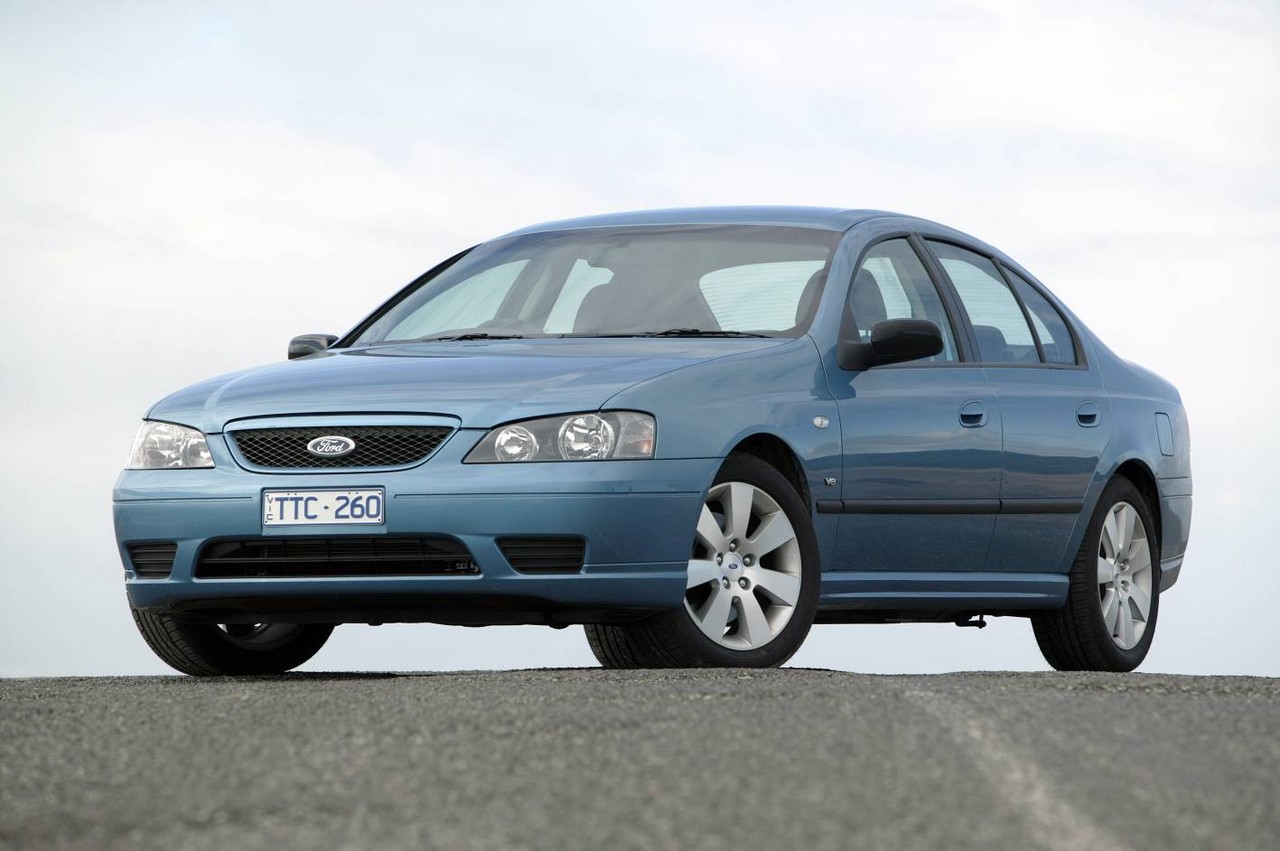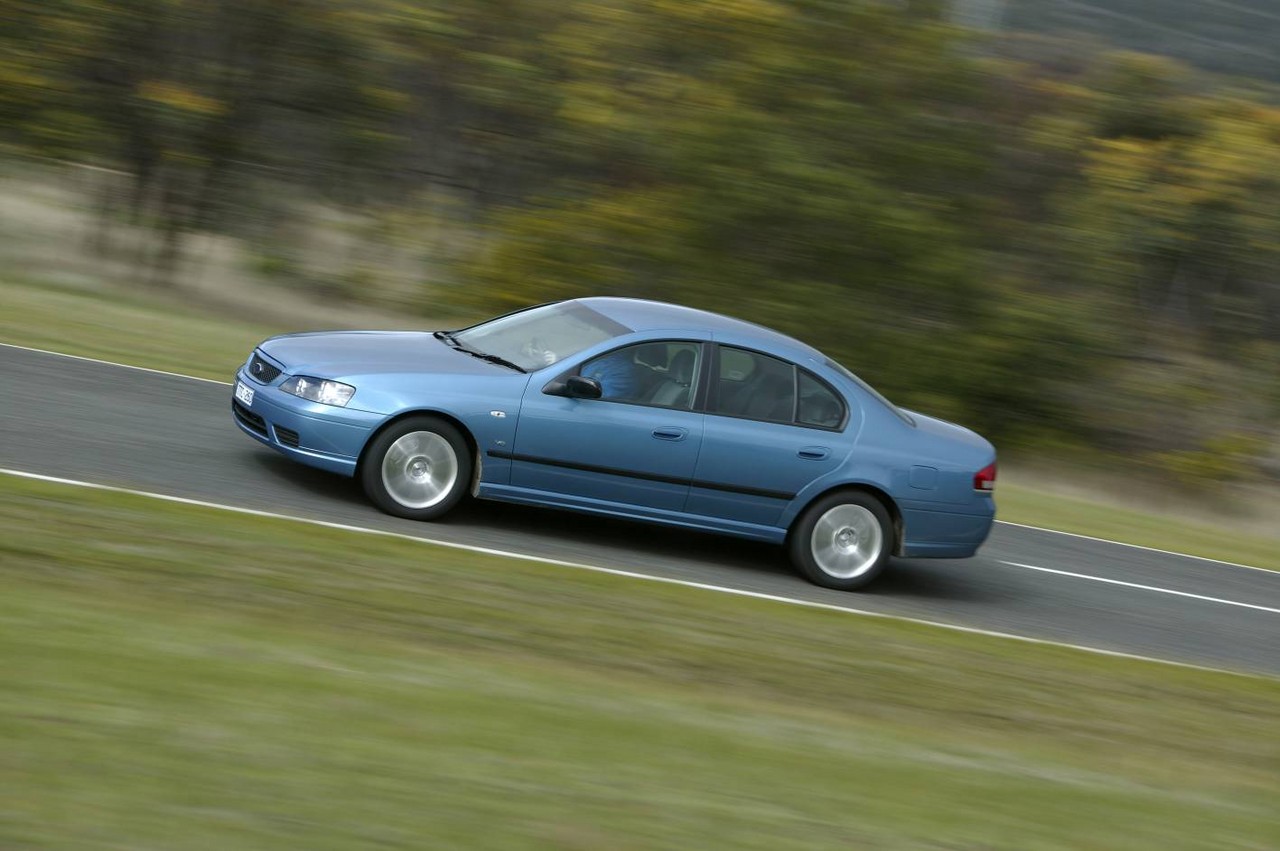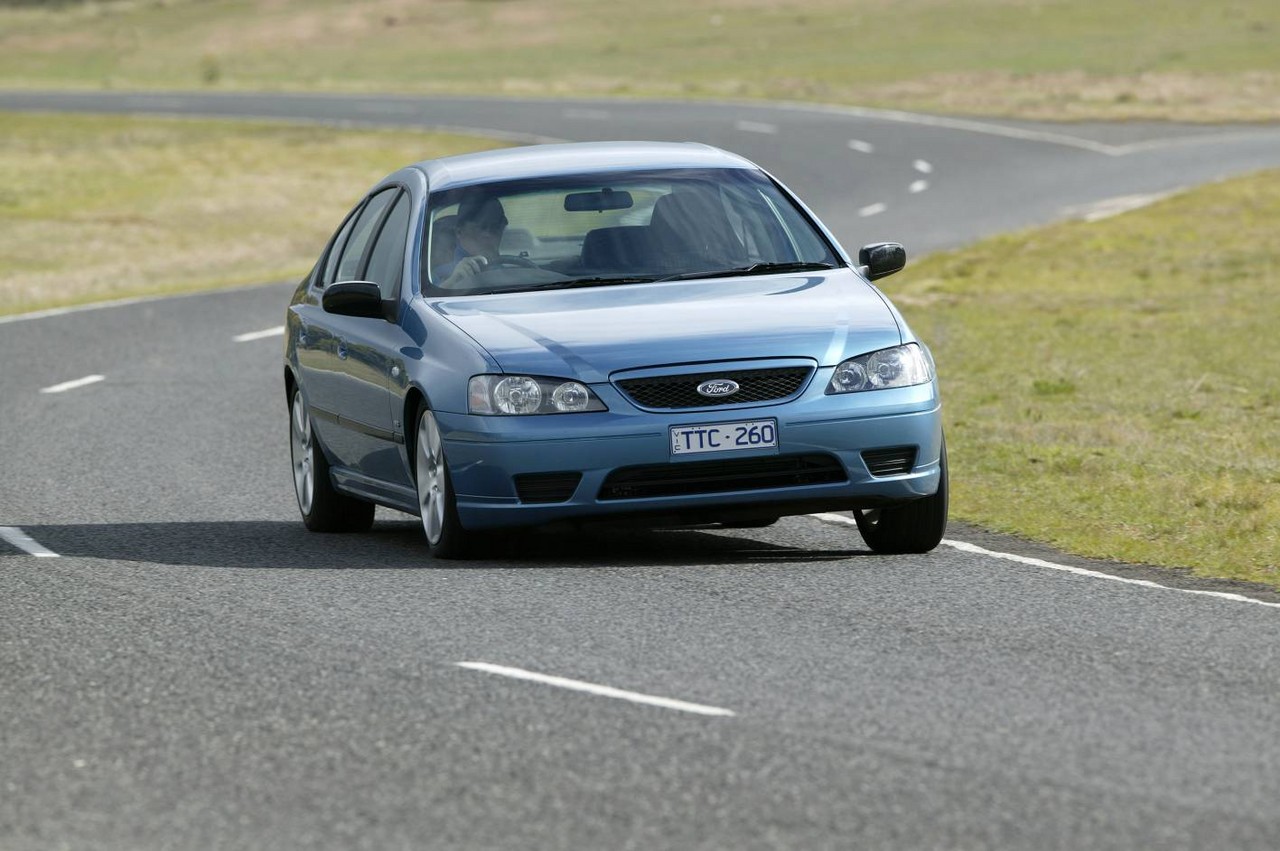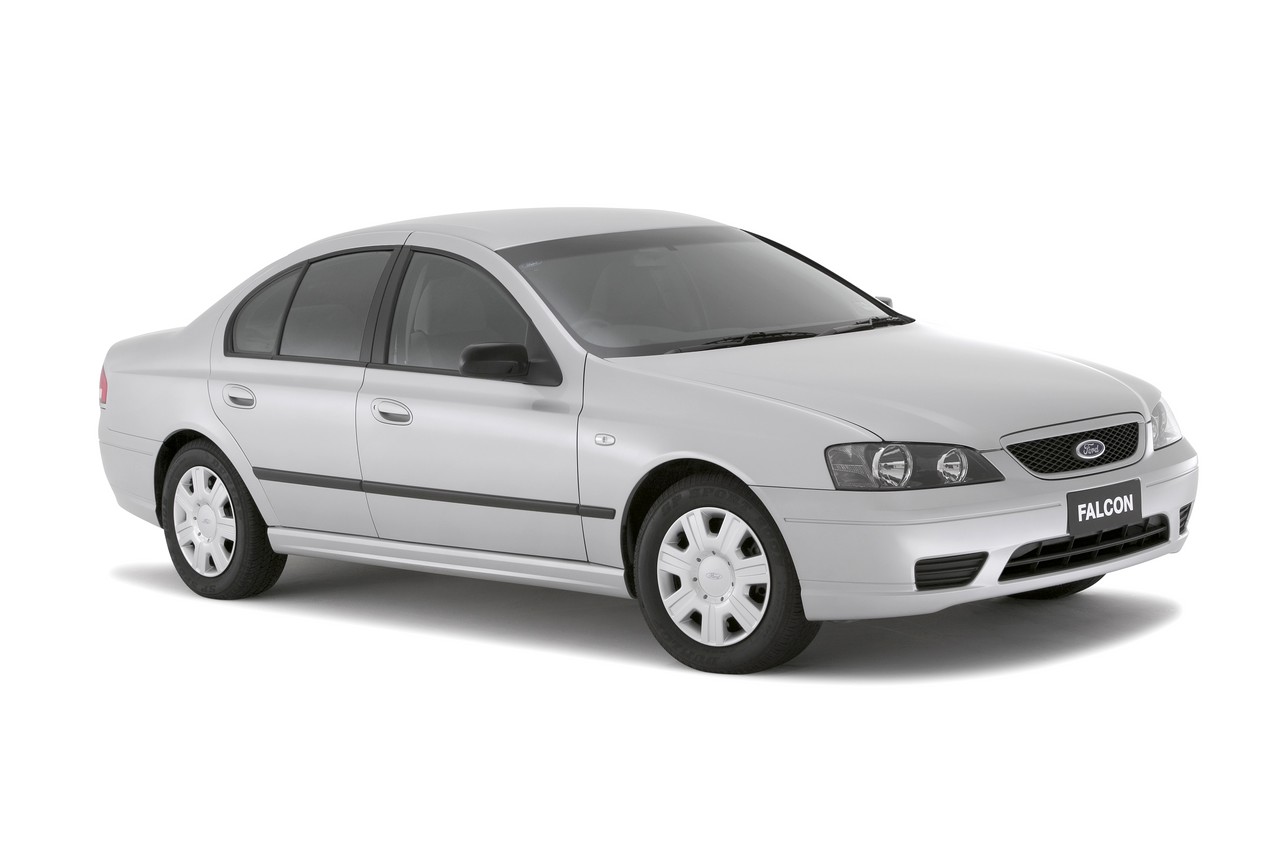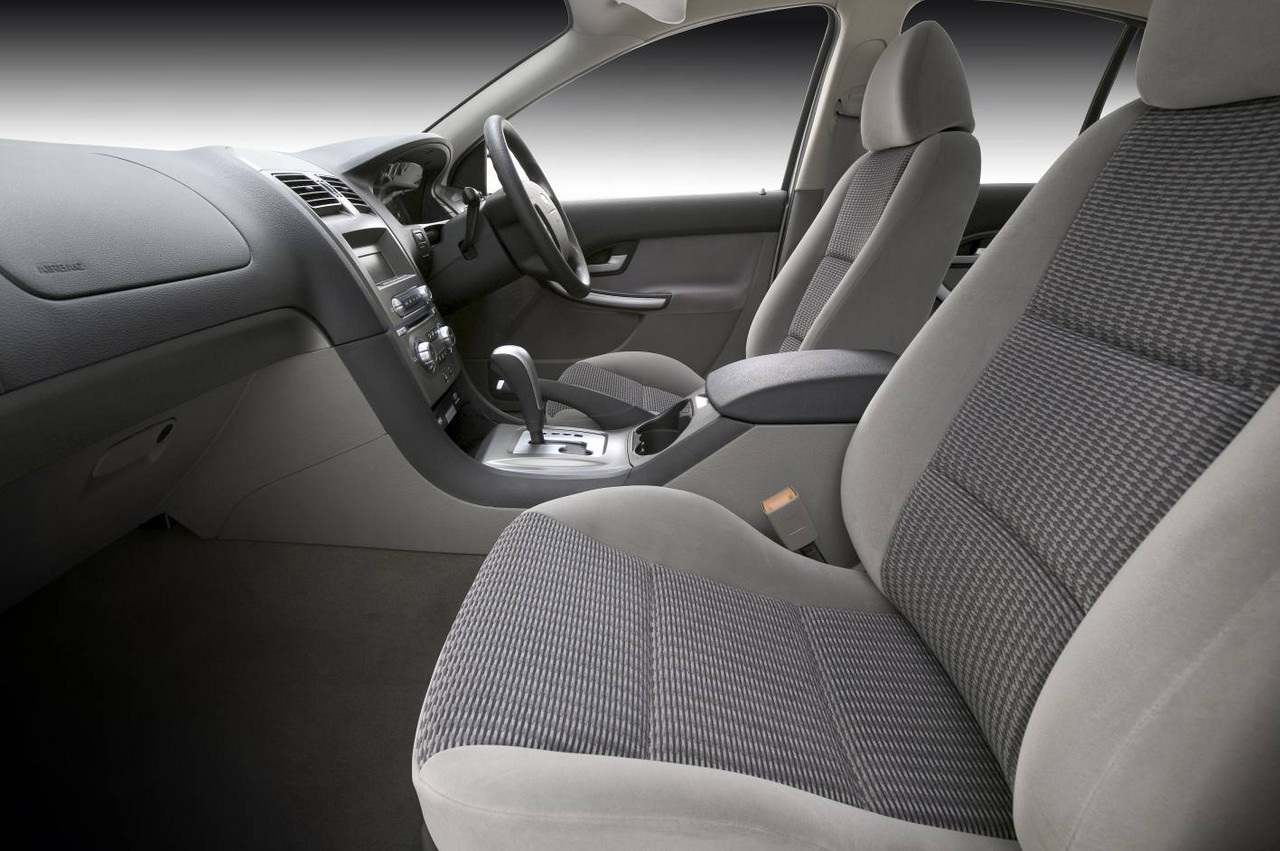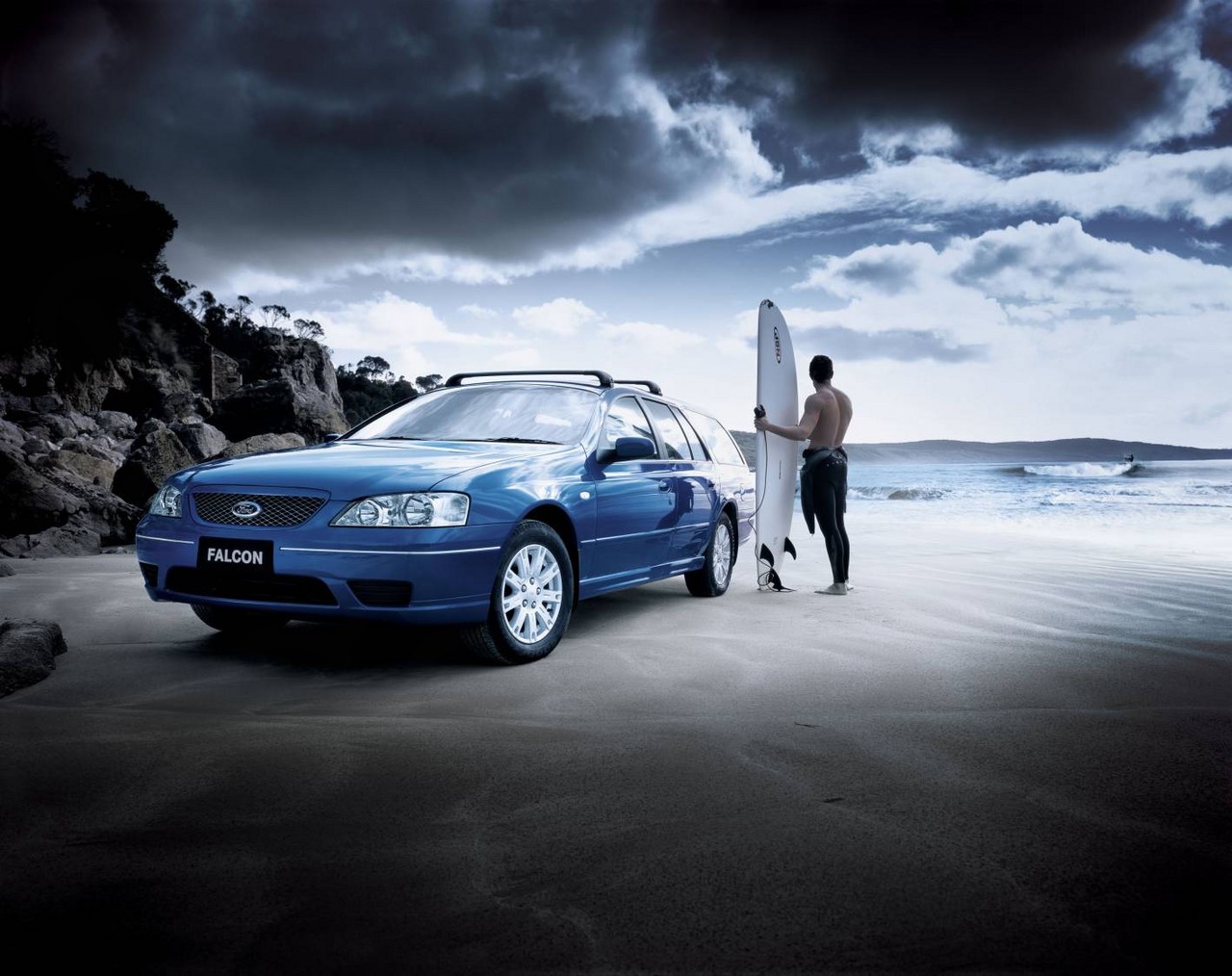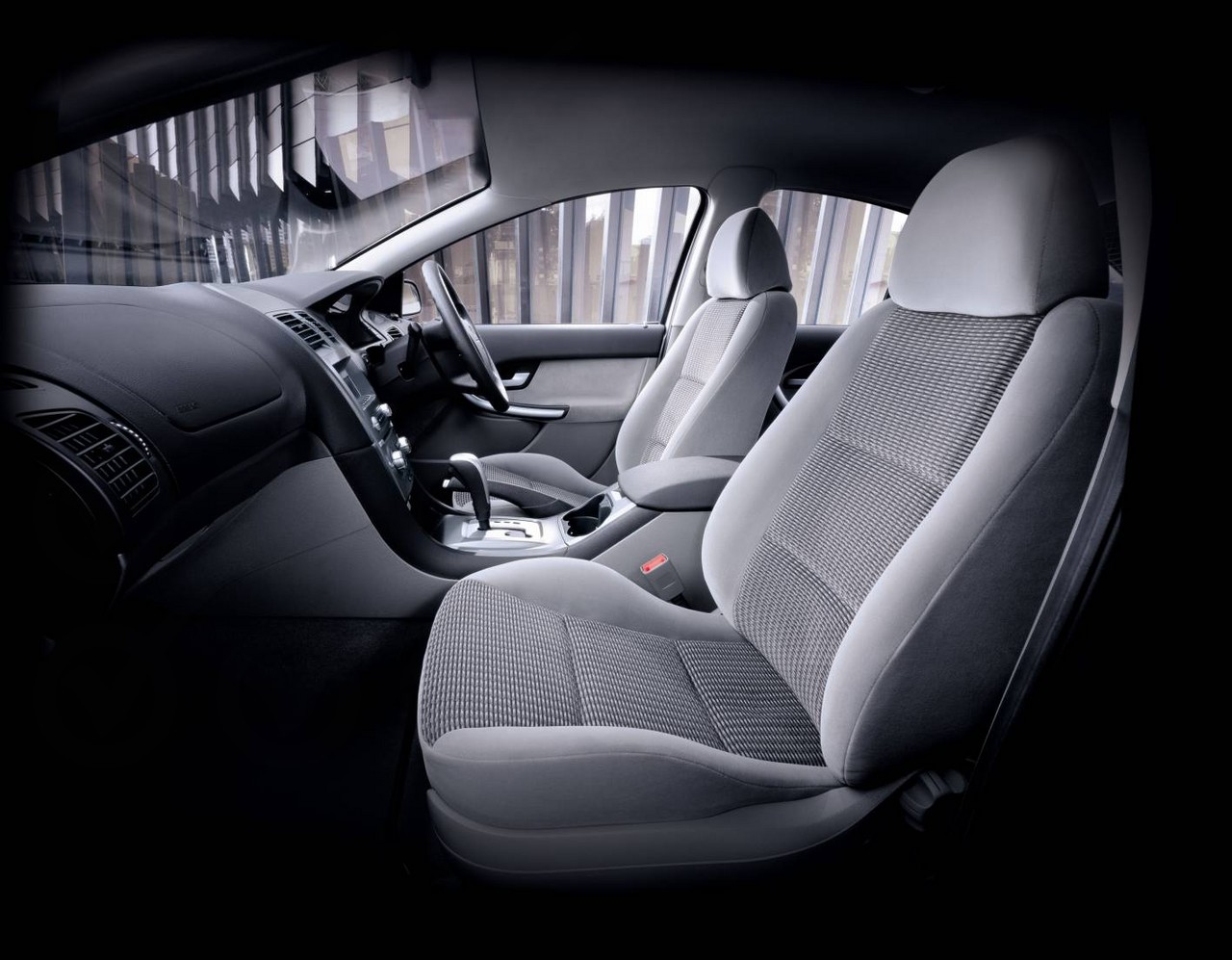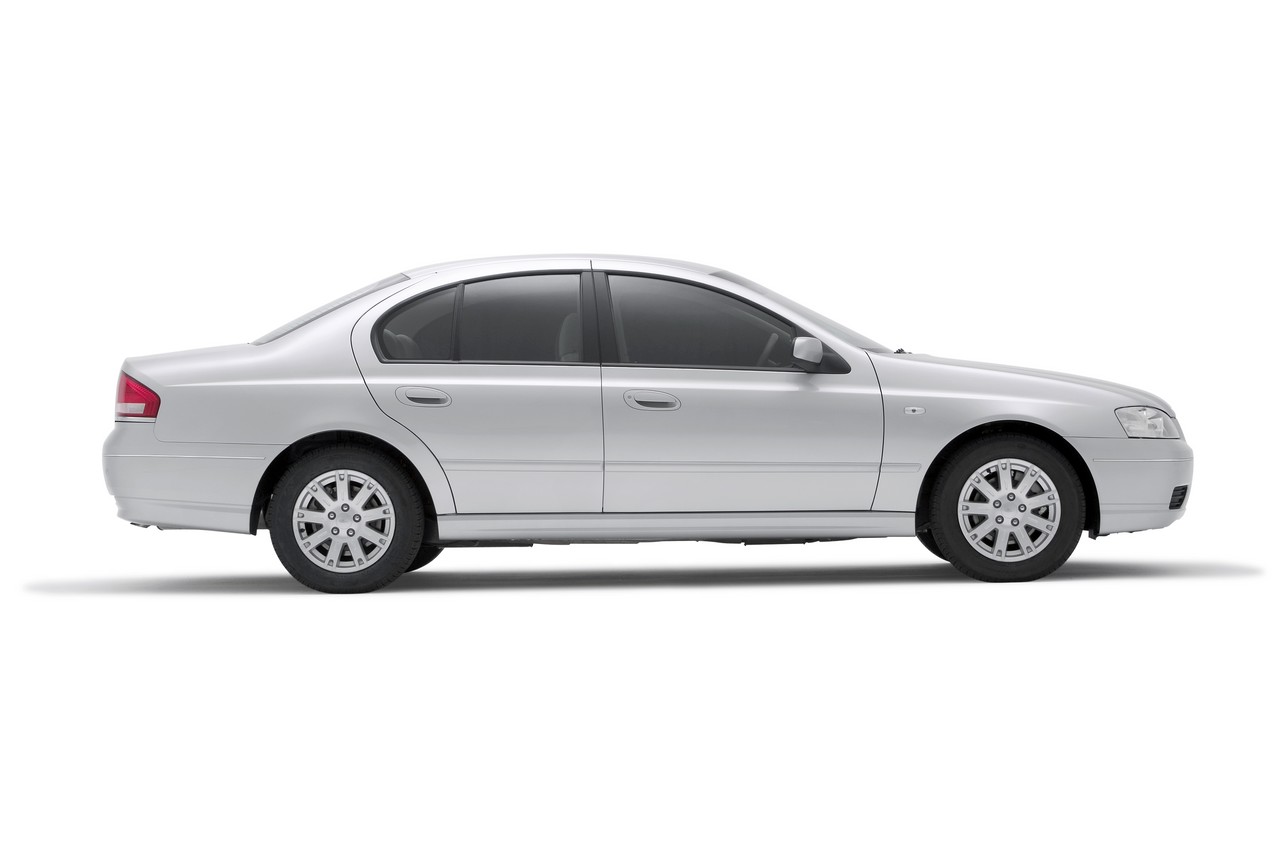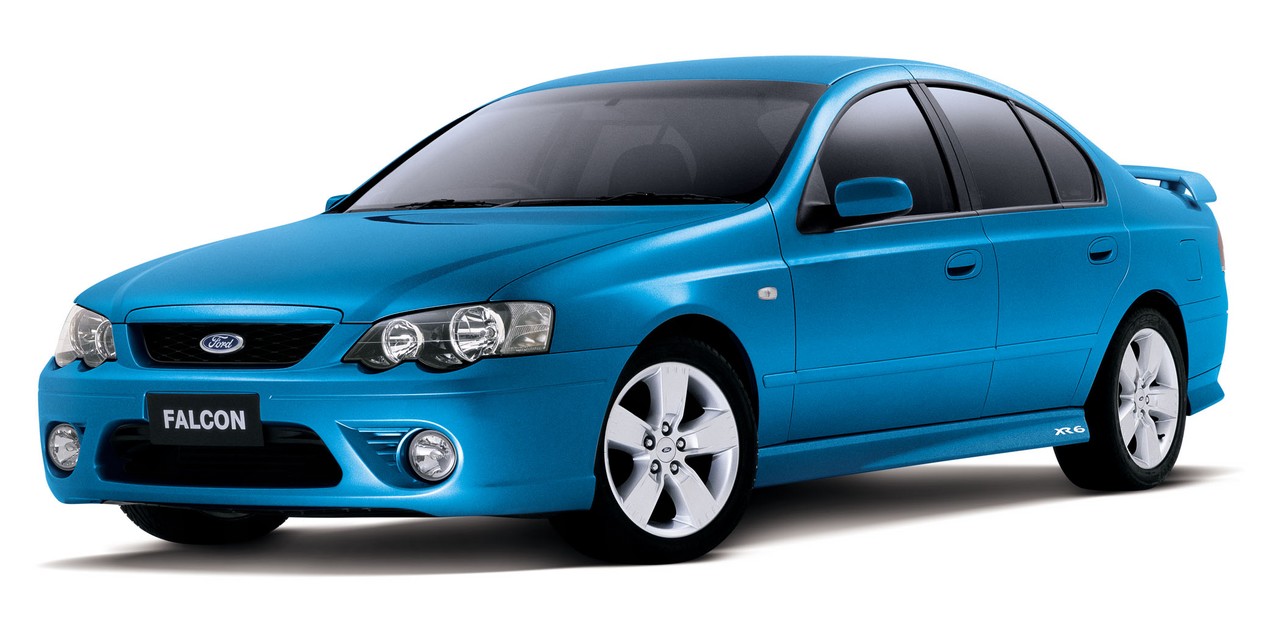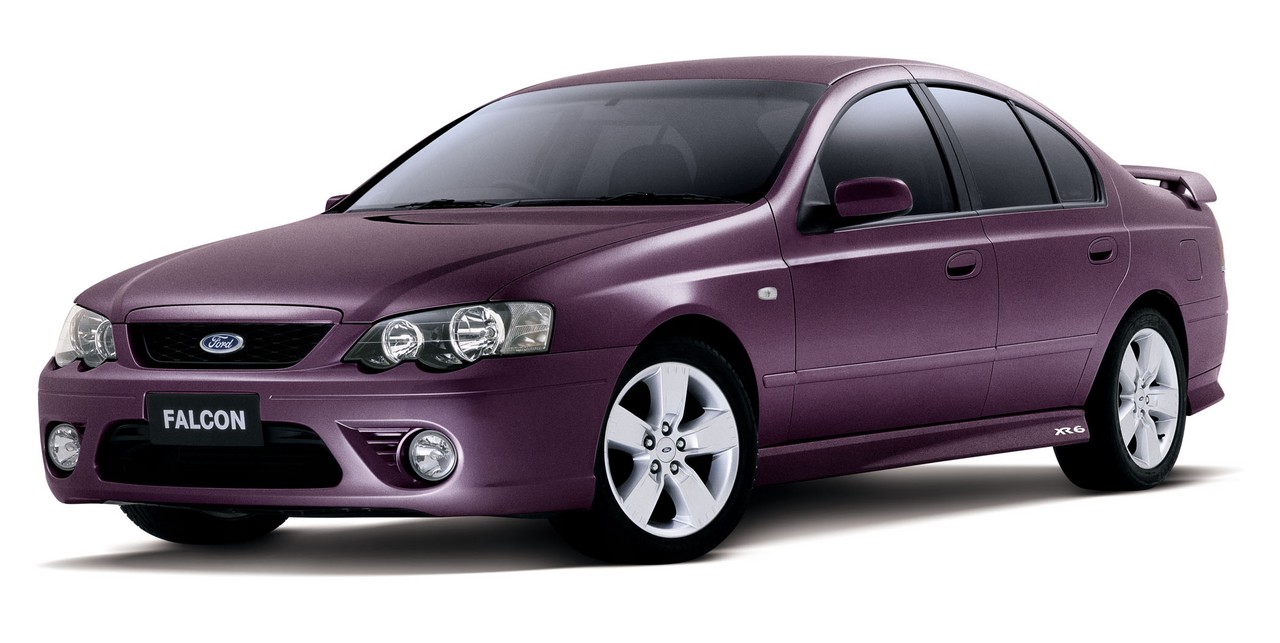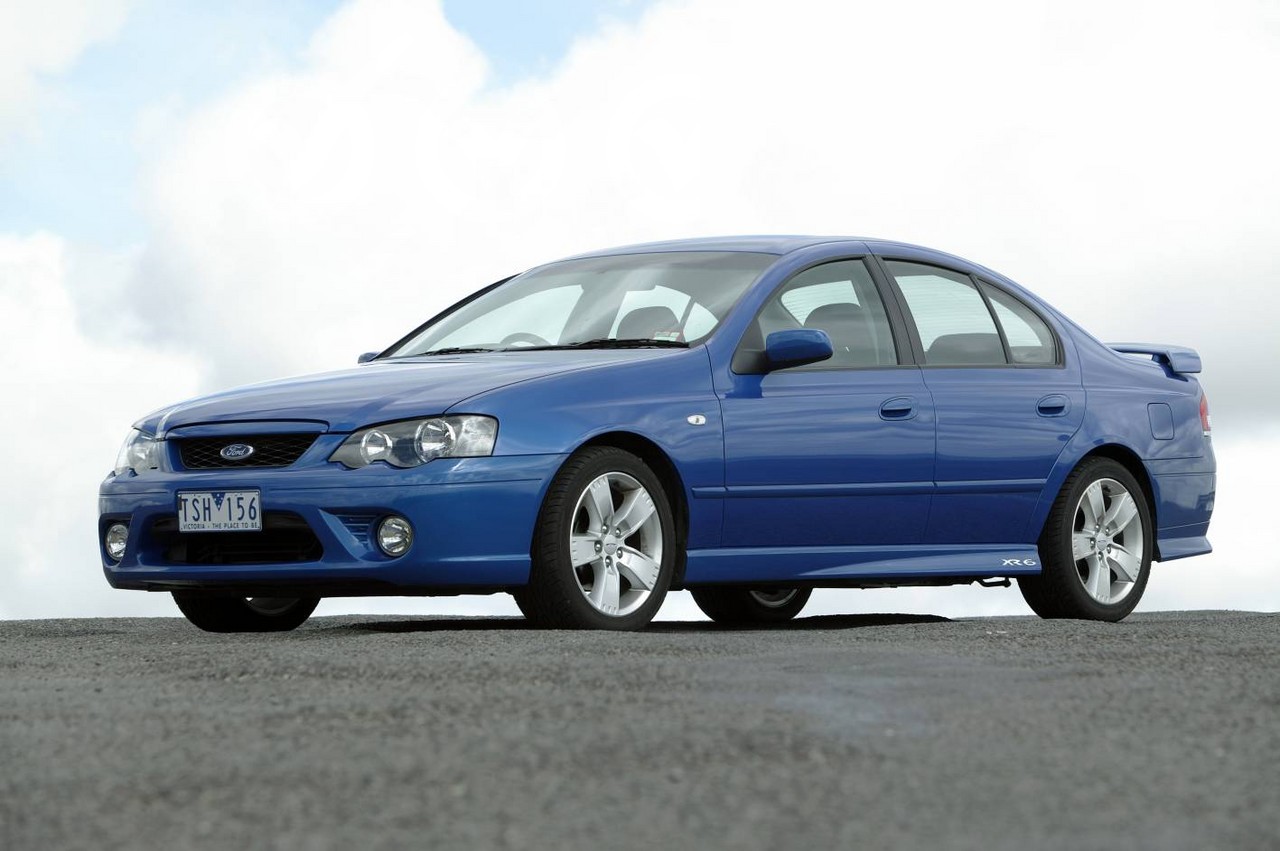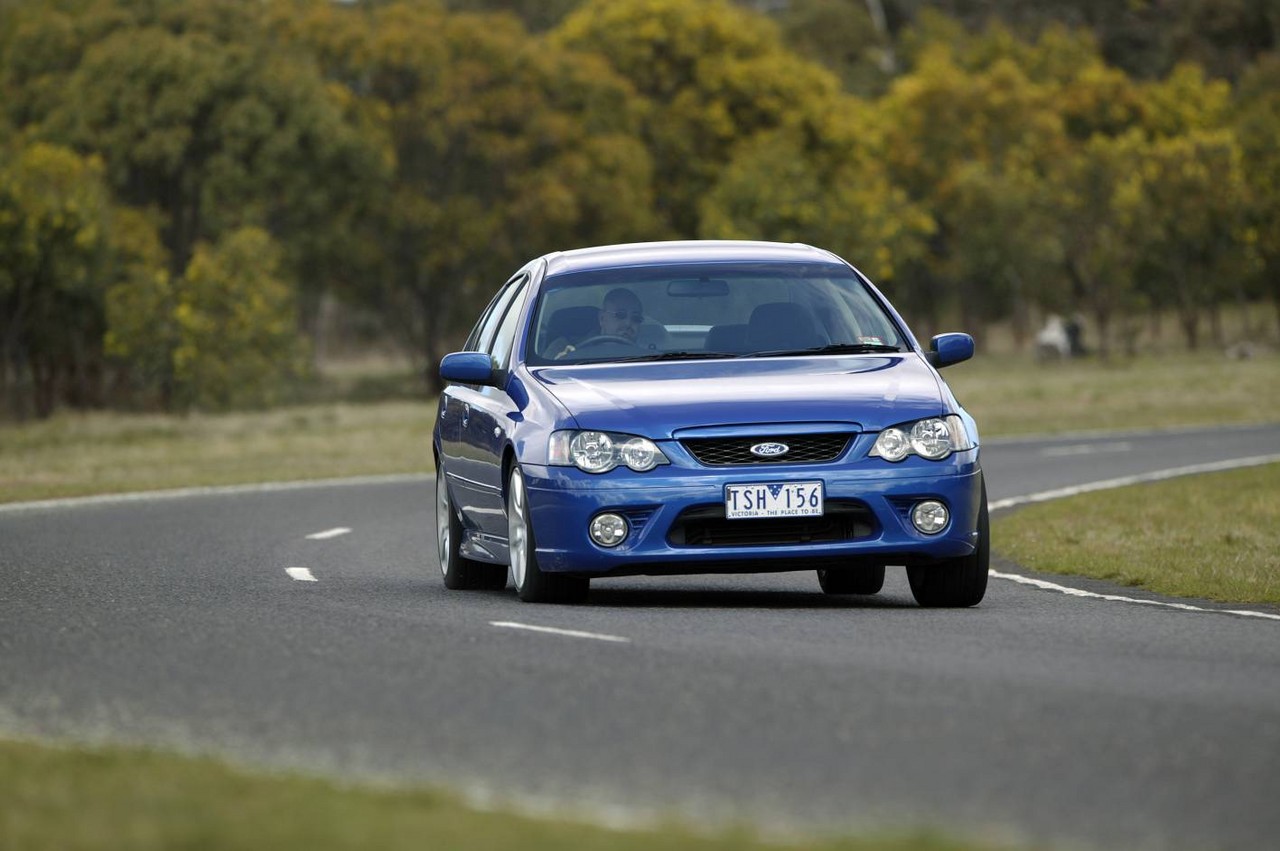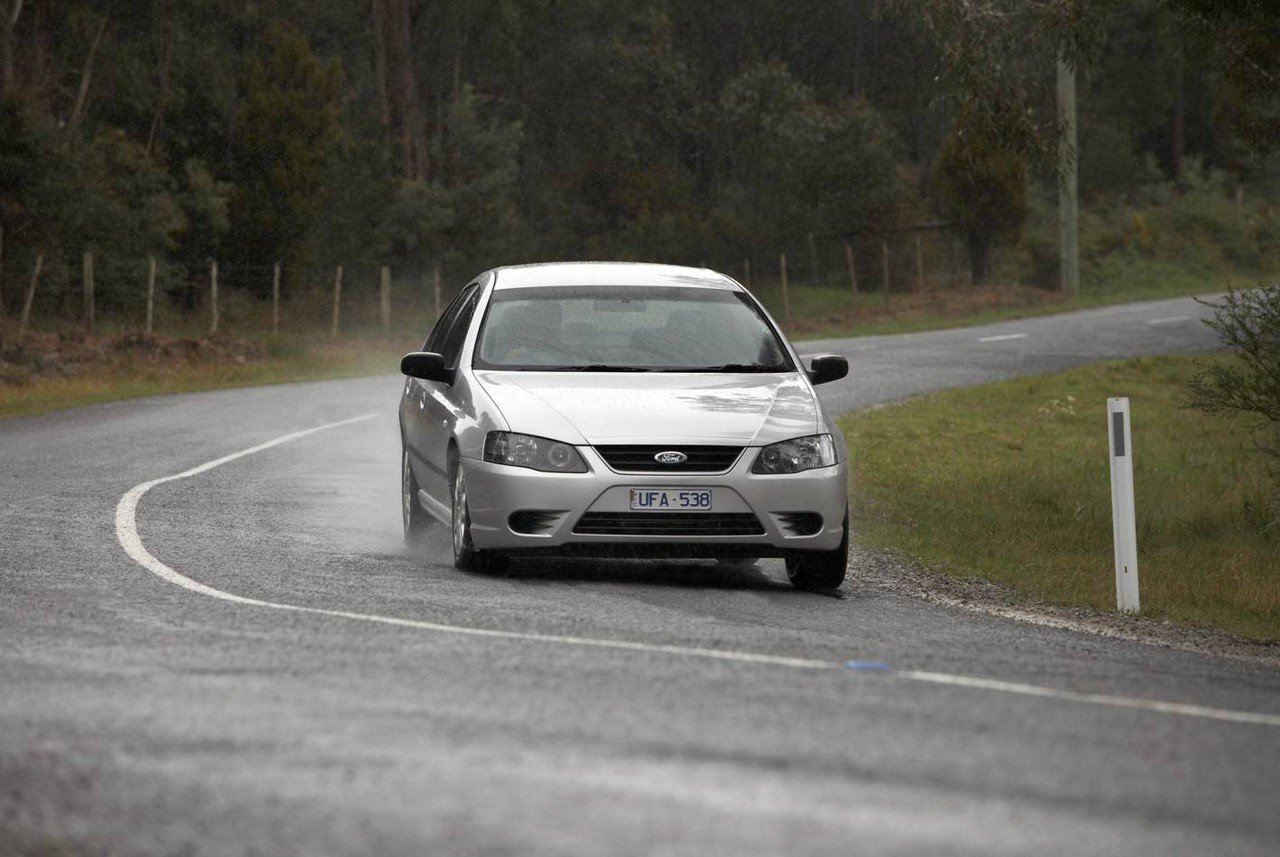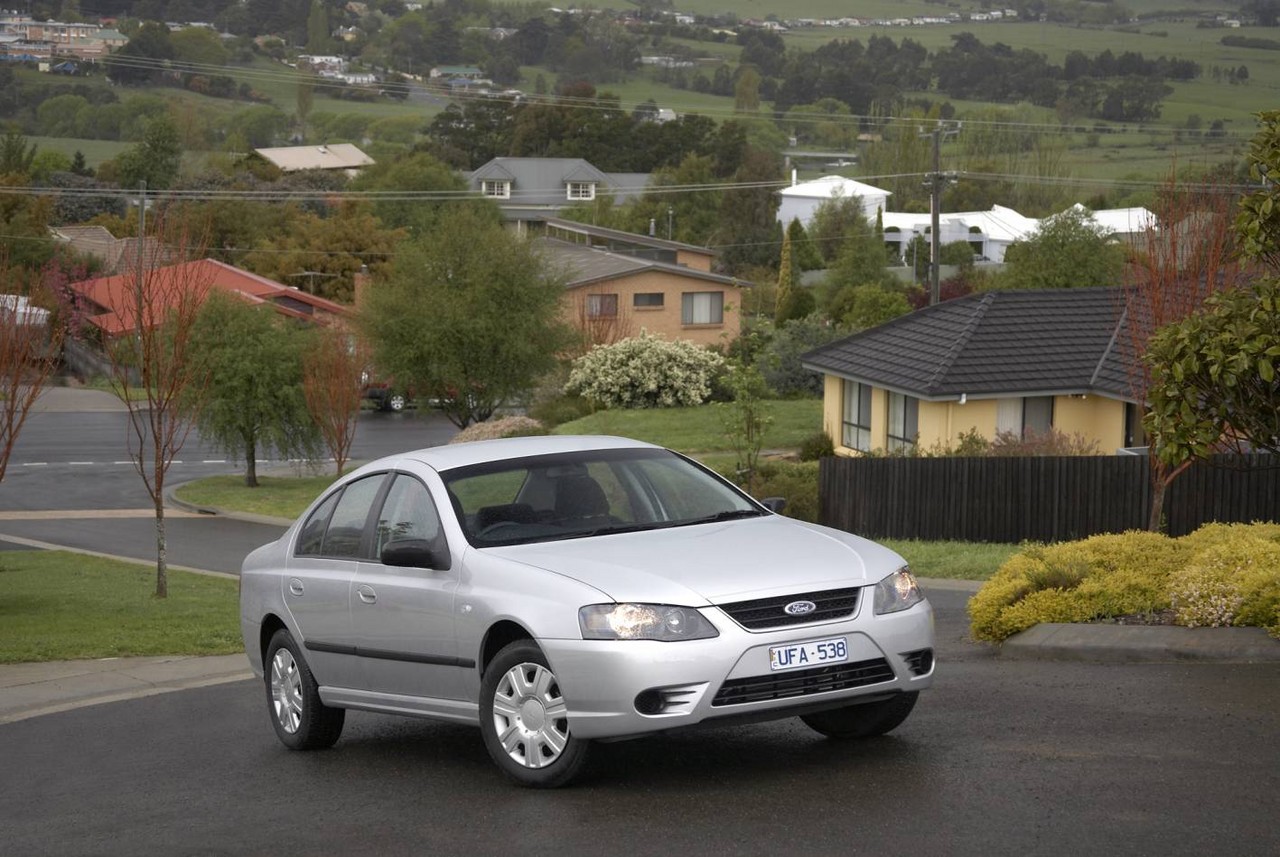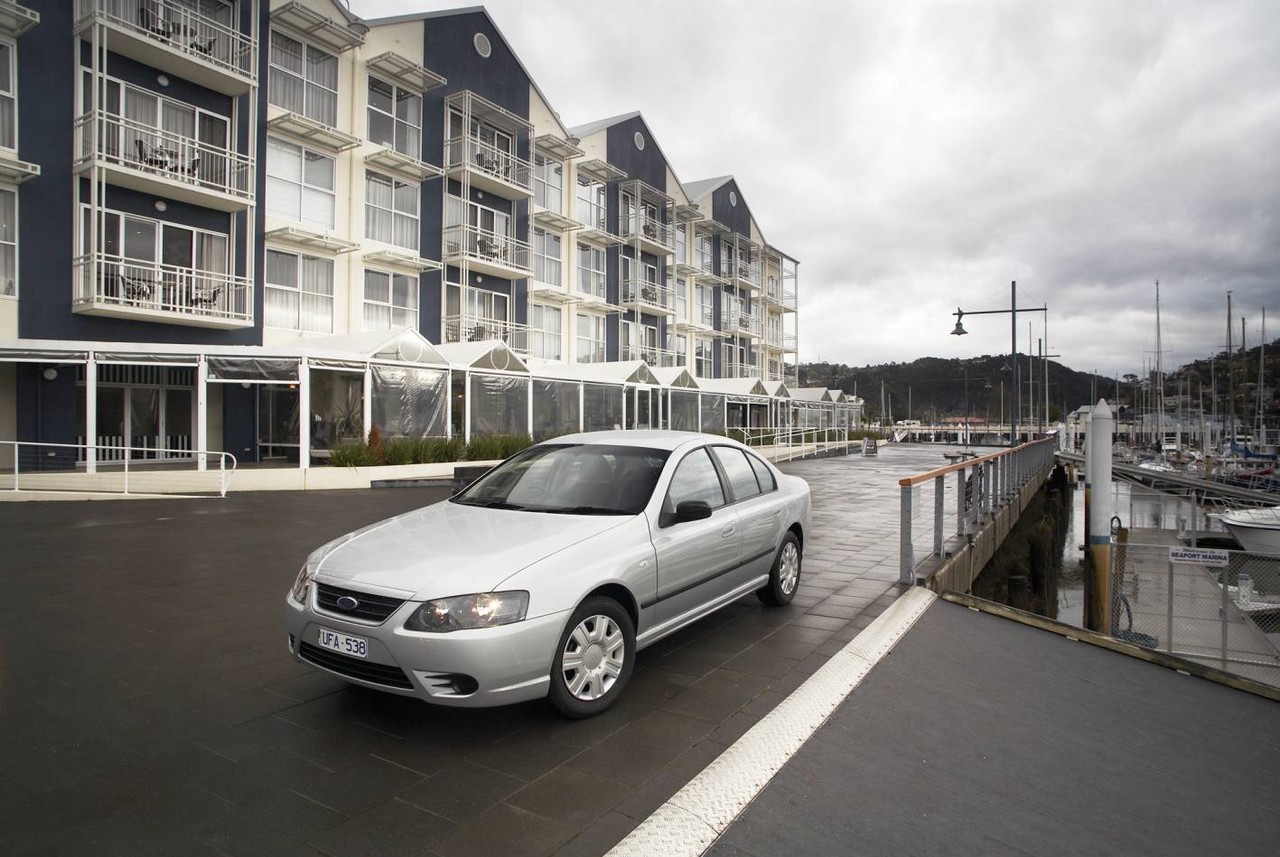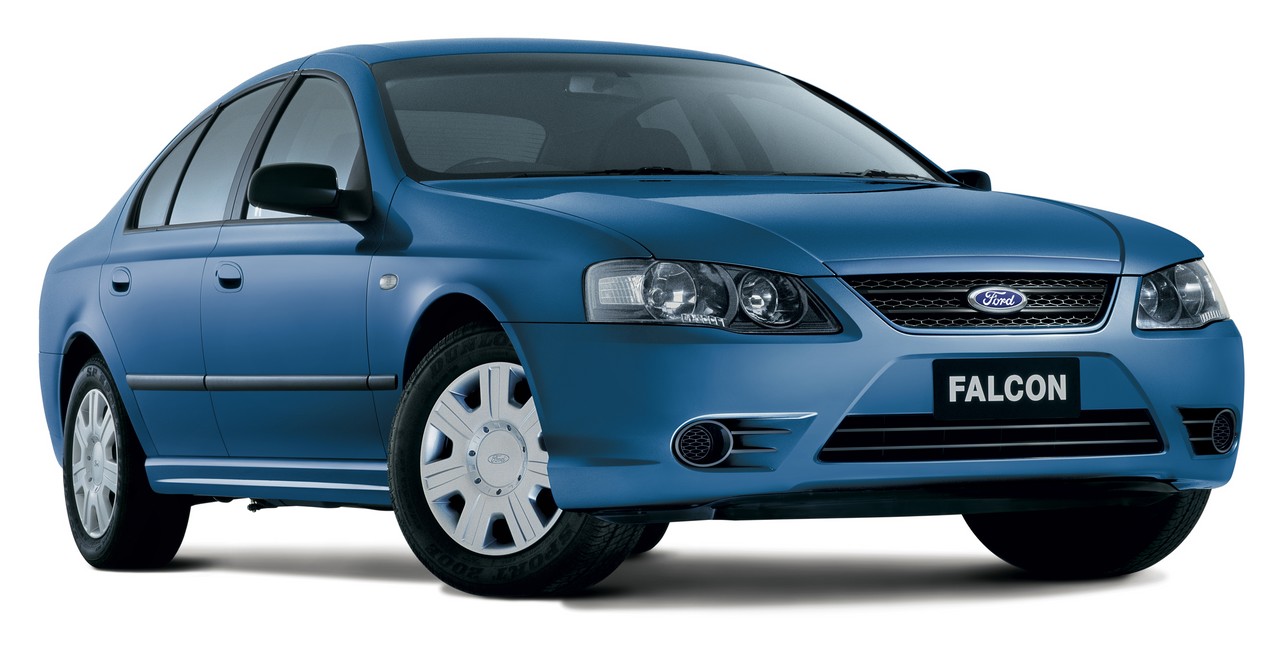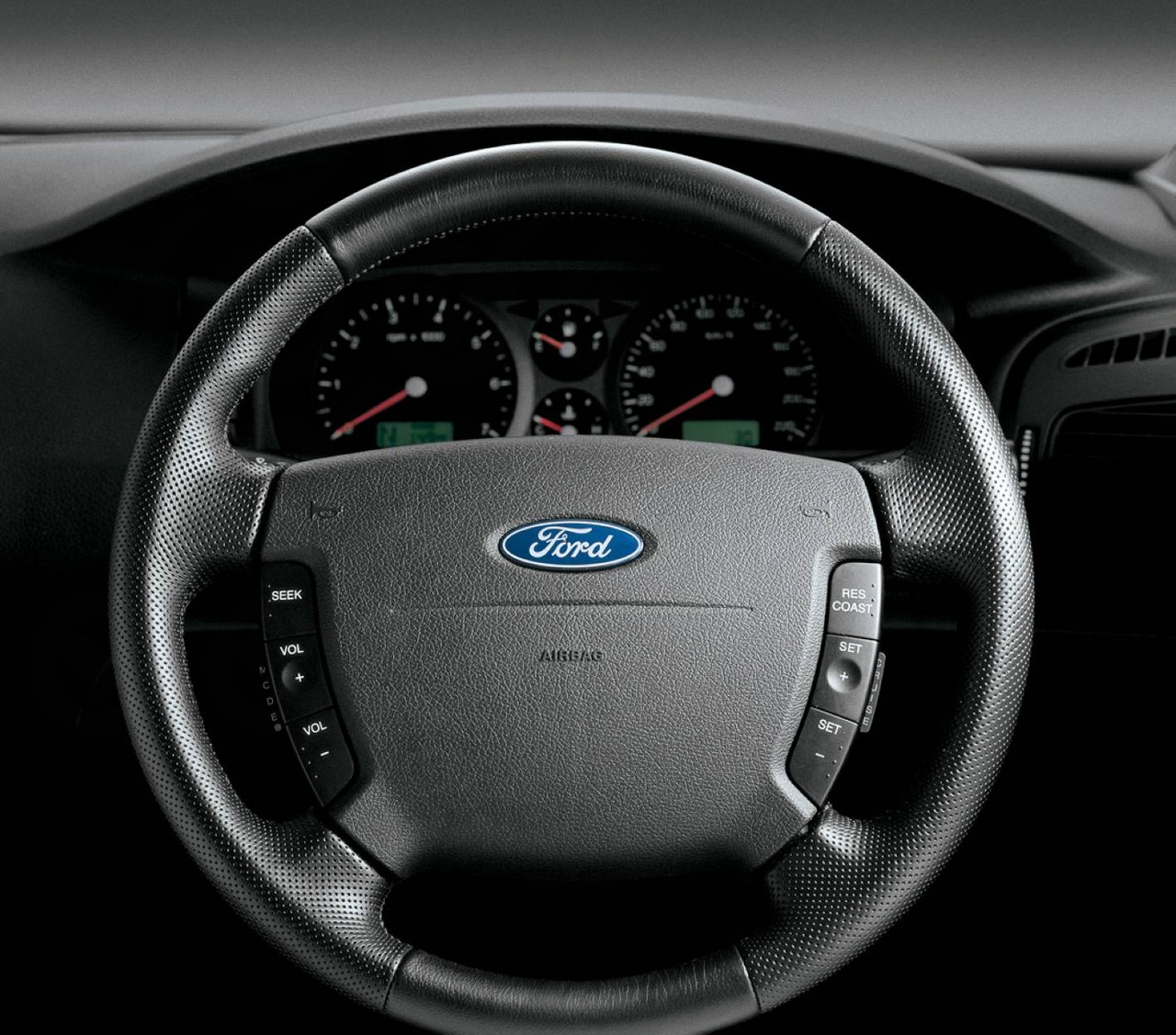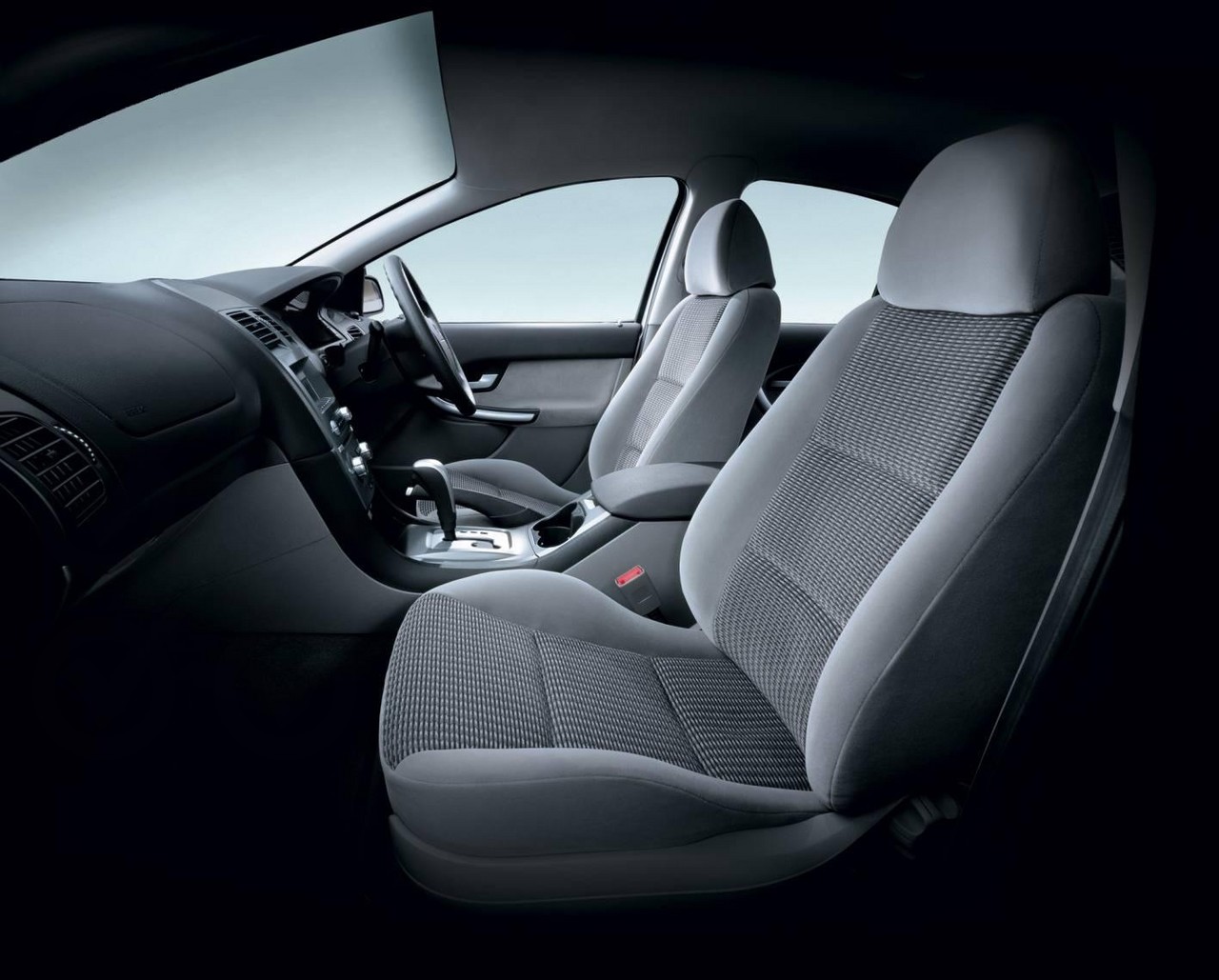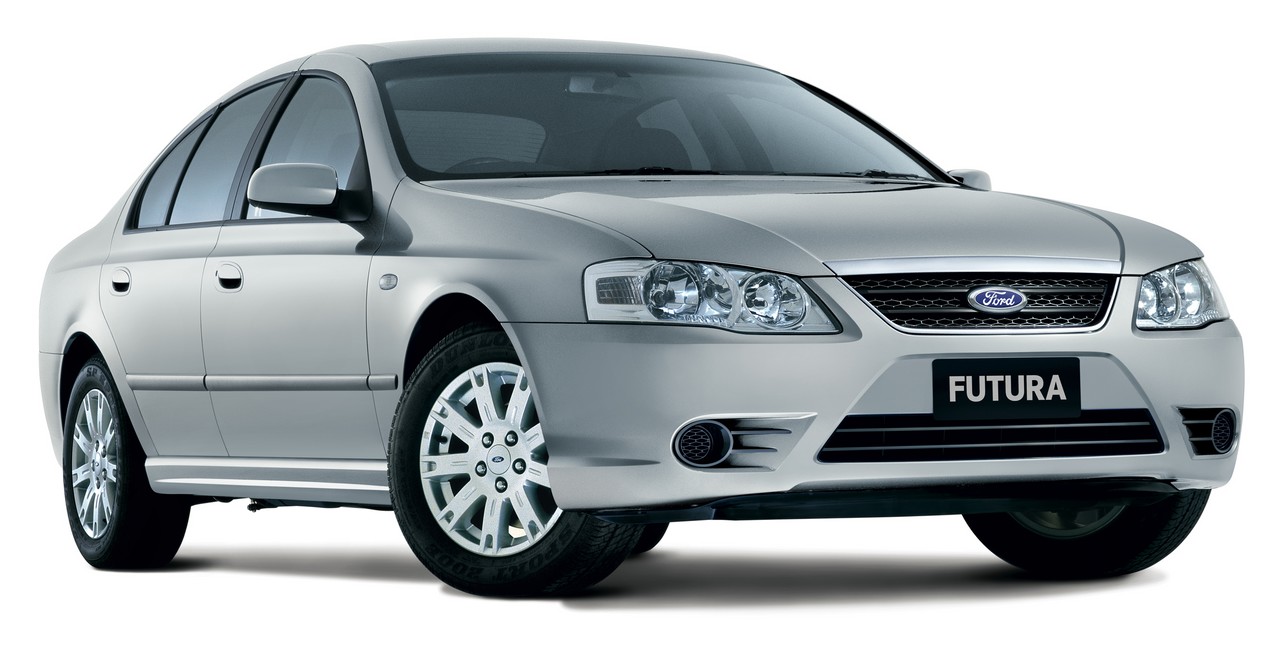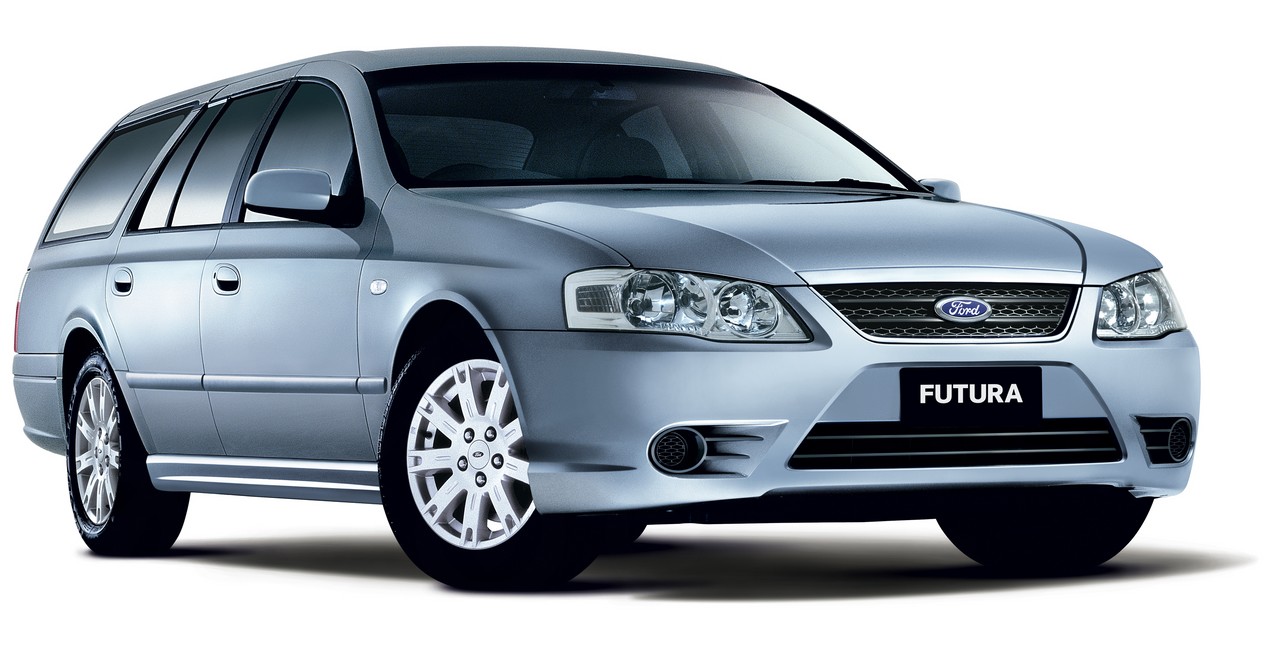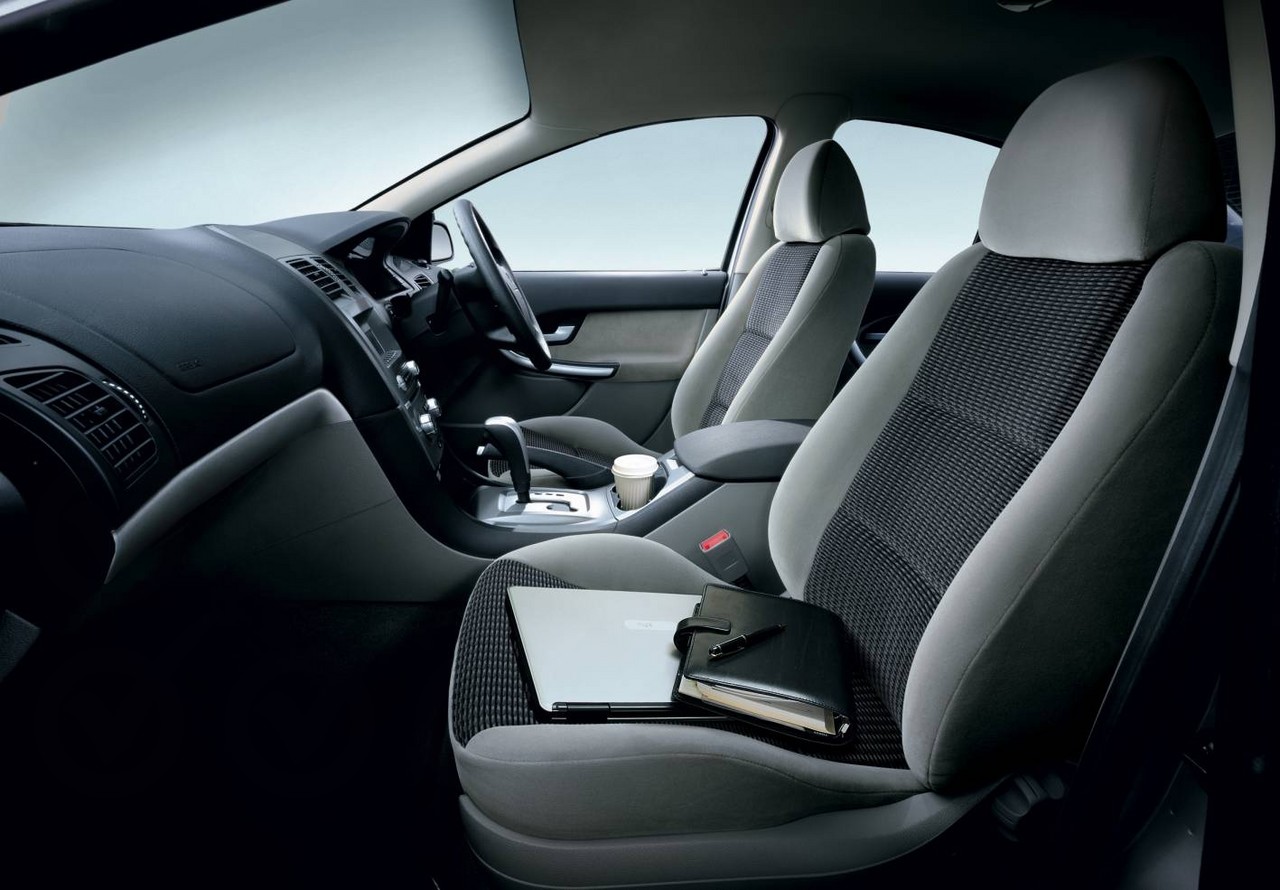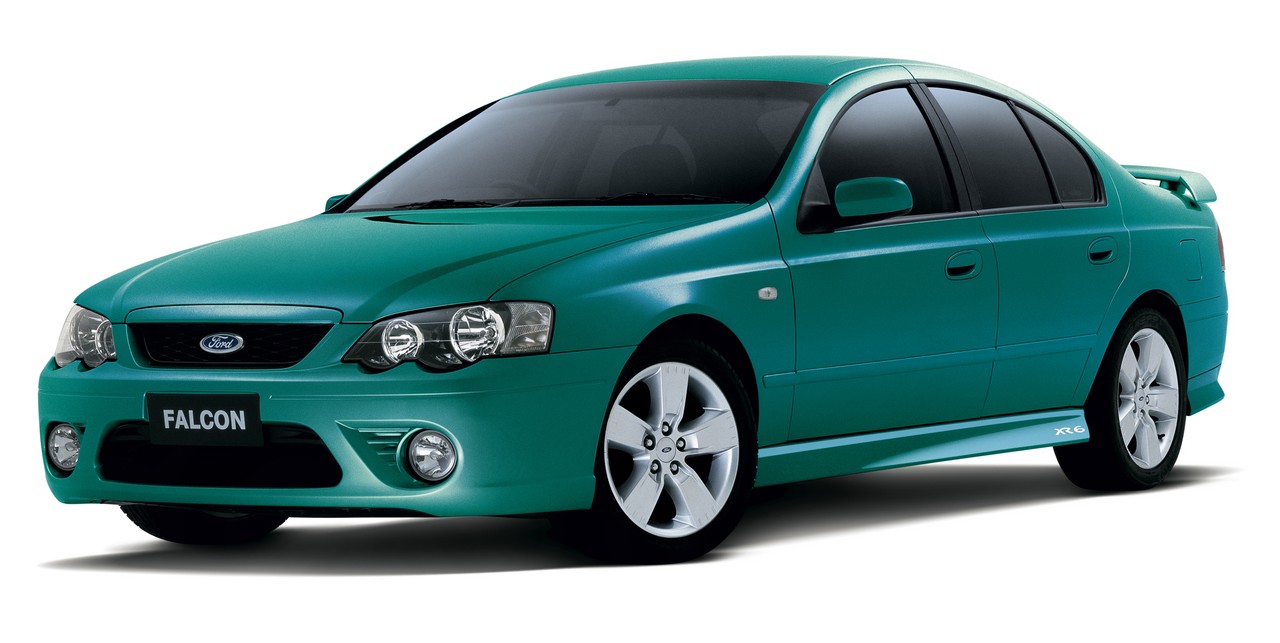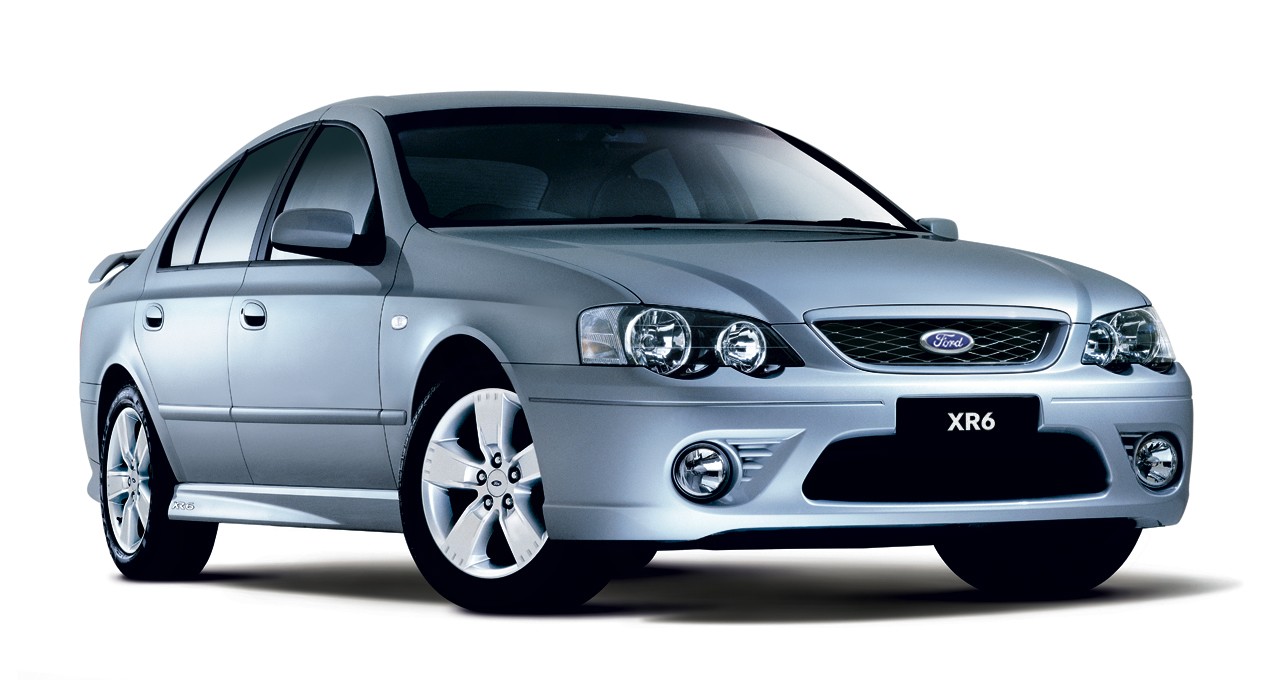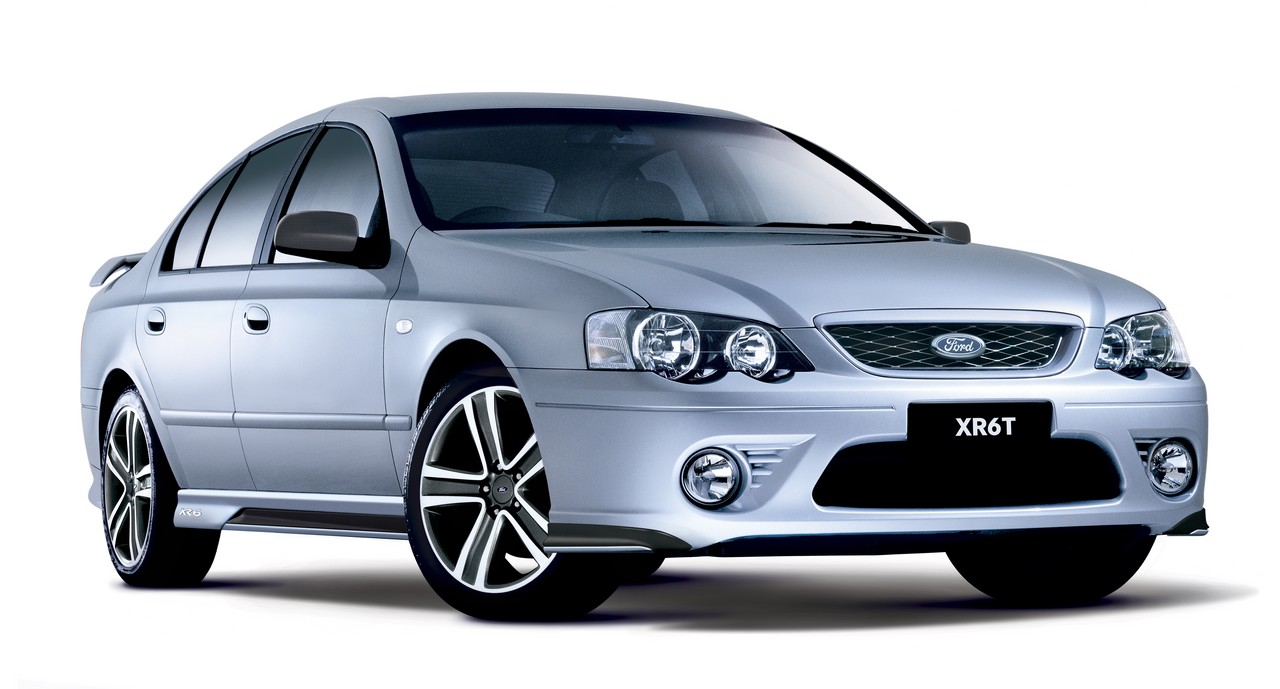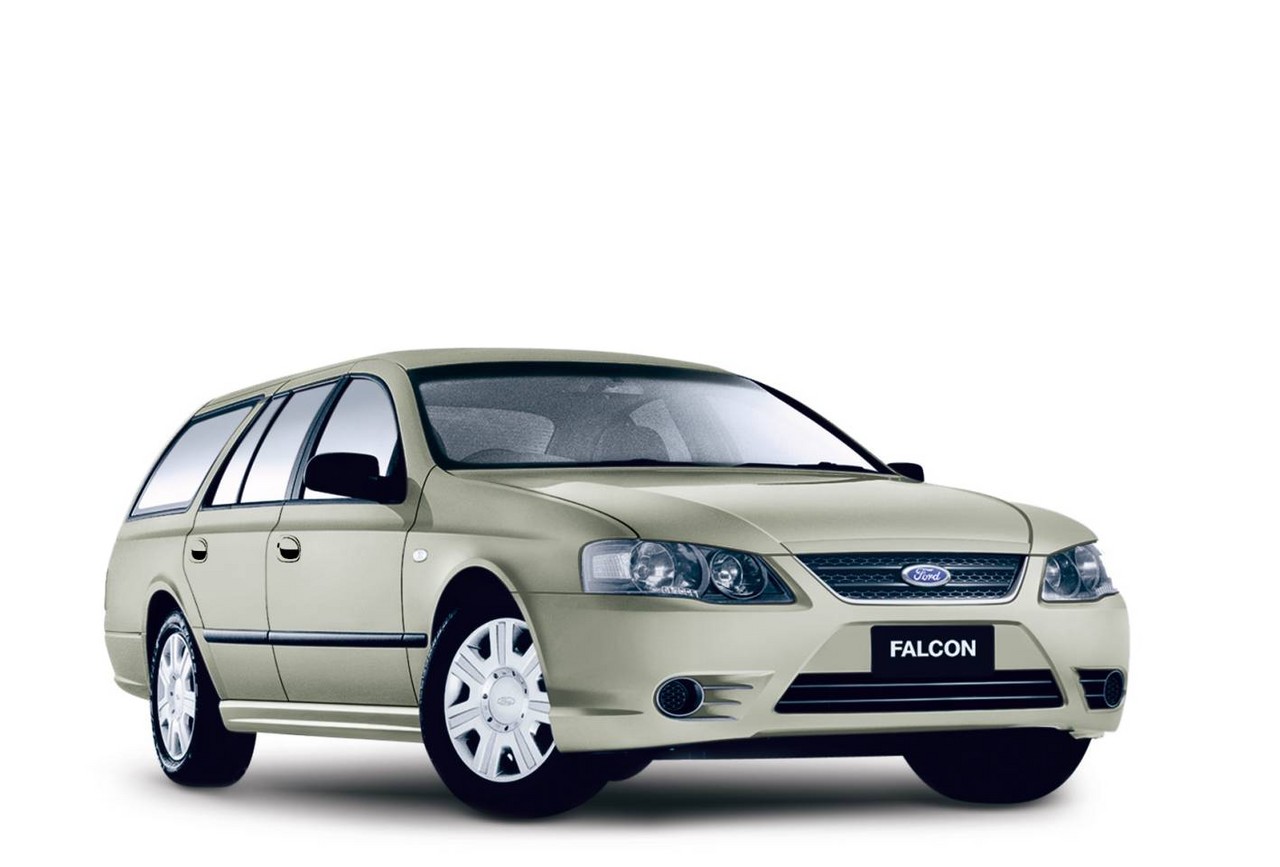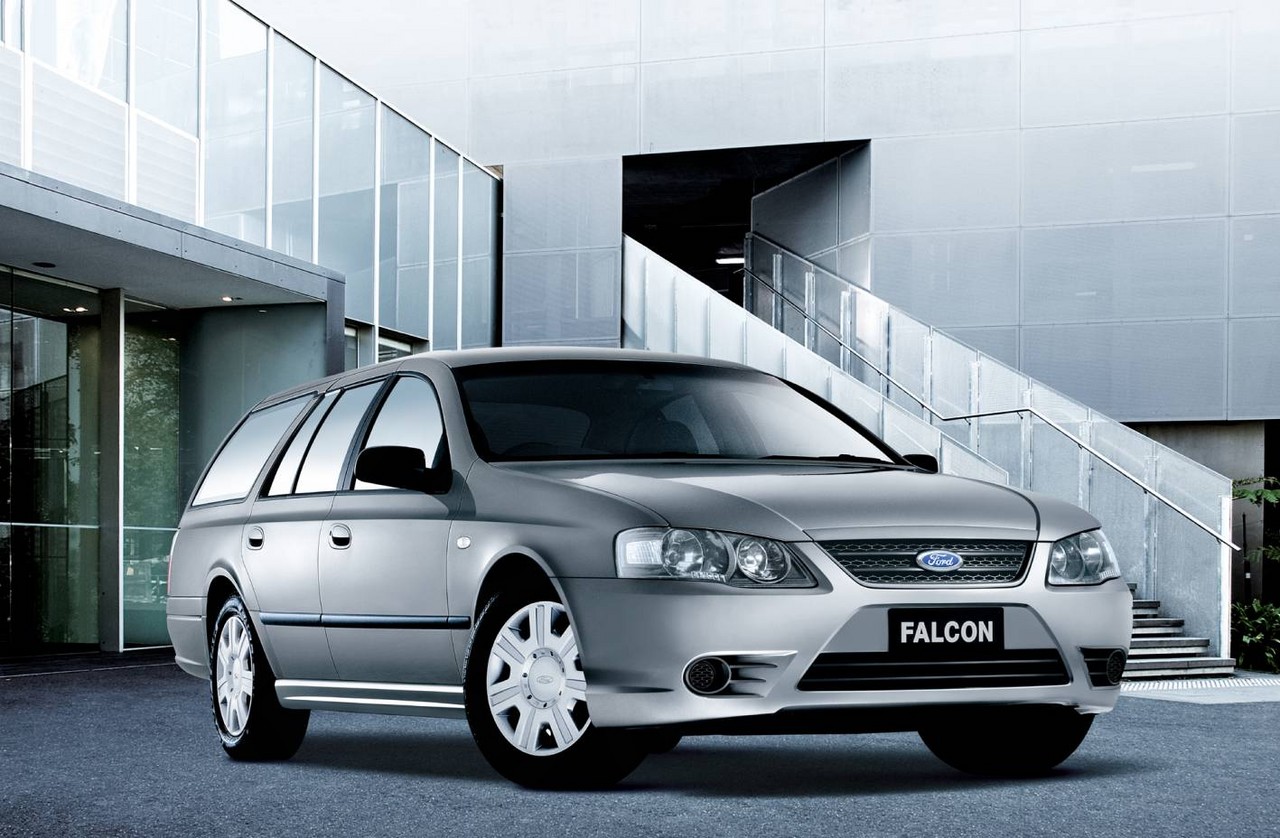
- Responsive and refined 4.0-litre six-cylinder engine
- Powerful engines for XR6 Turbo and XR8
- Accomplished ride/handling balance, while XR variants have impressive dynamics
- Quiet and spacious interior
- Steering provides good feedback
- Refined six-speed ZF automatic transmission
- Cast-iron 4.0-litre engines are heavy and not particularly fuel-efficient
- Variable build quality
- Coolant lines for automatic transmission cooler susceptible to failure
- ‘Control Blade’ semi-trailing arm rear suspension inferior to VE Commodore-based four-link IRS, particularly for high-powered applications
Review: Ford BF.I Falcon (2005-06)
Overview
Released in October 2005, the Ford BF Mark I (BF.I) Falcon was available as a large sedan or wagon. Manufactured in Campbellfield, Victoria, the rear-wheel drive Ford BF Falcon was available with either a by 4.0-litre inline six cylinder petrol engine (naturally aspirated and turbocharged), a 4.0-litre dedicated LPG engine or a 5.4-litre V8 engine. The BF.I Falcon range initially consisted of XT, Futura, XR6, XR6 Turbo and XR8 variants; in February 2006, the range was expanded by the limited-run Falcon SR.
Engines: Barra 190, Barra 245T, E-Gas, Barra 230 & Boss 260
Of the engines,
- The 4.0-litre Barra 190 inline six-cylinder petrol engine had a cast iron block, a cast aluminium cylinder head, double overhead camshafts (DOHC, simplex chain-driven), dual independent variable camshaft timing, four valves per cylinder, Duratec-style finger followers, a dual resonance inlet manifold, coil-on-plug ignition, electronic throttle control, exhaust gas recirculation and a compression ratio of 10.3:1. Compared to its Barra 182 predecessor, changes for the Barra 190 engine included independent variable camshaft timing (i.e. each phaser could rotate each camshaft independently), a revised camshaft profile, a second knock sensor so that ignition timing could be optimised for each cylinder, revised piston crown profiles for a higher increased compression ratio, lower viscosity engine oil (5W30 GF3, previously 10W30 GF2), a lighter driveplate assembly, a new air intake and a revised exhaust system (with a new front resonator and retuned centre and rear mufflers);
- For the Falcon XR6 Turbo, the Barra 245T engine added a Garrett GT3582R turbocharger which had engine oil-lubricated and water-cooled bearings, an air-to-air intercooler and an electronic single bypass wastegate. The turbocharger was mounted off a cast stainless steel exhaust manifold and provided maximum boost pressure of 6 psi (0.413 bar). Compared to the Barra 190 engine , the Barra 245T engine had ‘dished bowl’ shaped pistons, more temperature tolerant exhaust valves and increased fuel pressure (4.0 bar, compared to 2.4 bar). Like the Barra 190, however, the Barra 245T engine benefited from dual independent variable cam timing (VCT), a revised camshaft profile and dual knock sensors;
- Compared to the Barra 190 engine, the 4.0-litre Barra E-Gas dedicated LPG engine had a Vialle closed-loop single-point carburetion system, a compression ratio of 10.3:1 and hardened valves and valve seats. For the BF range, the E-Gas engine had a lower compression ratio since it shared its pistons with the Barra 190 engine, had a revised venturi (for better air/fuel mixing), throttle body and inlet pipe, and satisfied Euro III emissions standards. For sedans, the tank fitted under the rear of the vehicle and had a capacity of 93 litres (116 litres for wagons);
- The 5.4-litre Barra 230 V8 engine had a cast iron block, a cast aluminium cylinder head, sintered connecting rods, a single overhead camshaft (SOHC), variable intake camshaft timing (over 60 degrees relative to the crankshaft), three valves per cylinder (two intake, one exhaust), roller finger followers, coil on plug ignition and a compression ratio of 9.7:1. Changes for the BF range included the introduction of dual knock sensors for more aggressive ignition calibration, ECU modifications, a larger diameter rear muffler (previously shared with the same Barra 182 ) and Euro III emissions compliance; and,
- Assembled by hand in Campbellfield, the 5.4-litre Boss 260 V8 engine had double overhead camshafts, four valves per cylinder and a compression ratio of 9.52:1, but omitted the variable cam timing of the Barra 230. The Boss 260 engine combined the long stroke 5.4-litre block with Mustang Cobra R heads and changes included high-lift camshaft profiles, specific inlet camshaft to match the high-rise inlet manifold and exhaust header system, forged steel crankshaft, Boss fuel rail with upgraded injectors, 75 mm throttle body, low-restriction air-intake with a conical filter, 1 7/8inch stainless steel exhaust headers, and an FPV oil pan and oil pick-up.
For the BF range, ‘transient’ rpm limits were introduced for the six cylinder engines which momentarily allowed engine speed to exceed the prescribed rev limit during upshifting – this enabled wide open throttle upshifting to occur at an engine speed closer to the rev limiter than would otherwise be possible.
Transmissions
Of the transmissions,
- The naturally aspirated six-cylinder engines were available with four-speed BTR M93LE (also known as ION 93-4AT) automatic, five-speed BTR T5 manual transmissions or six-speed Tremec T56 manual transmissions (the latter reserved for the XR6); and,
- The XR6 Turbo and XR8 were available with six-speed ZFHP26 automatic or six-speed Tremec T56 manual transmissions.
For the BF range, the four-speed BTR M93LE automatic transmissions were upgraded with:
- Stronger gearsets;
- Radial dead-end groove clutch plates and a second ‘Ball Check valve’ in the valve body for improved oil flow;
- The introduction of Grade Control Logic (previously introduced in the SX Territory );
- An accelerator pedal detent and kickdown switch;
- Revised software for improved shift schedules; and,
- Calibration improvements for more refined and consistent shift feel.
First introduced in the BMW E65 and E66 7-Series , the six-speed ZF 6HP26 automatic transmission was available in two versions: a standard version with a torque capacity of 450 Nm and a high-performance 600 Nm version (for use with the Barra 230, Barra 245T and Boss 260 engines) which had upgraded clutches with extra plates in the clutch packs. For its use in the BF Falcon, hardware changes for the ZF 6HP26 transmission included a unique transmission main case, torque converter, output/driveshaft flange and a new transmission cross member attachment (shared with the four-speed automatic). The ZF transmission featured adaptive ‘Driver Recognition’ behaviour, including brake support downshifts, gear holding when cornering, gear holding for uphill and downhill driving and gear holding for fast-off throttle driving situations.
For all automatic transmissions, a new remote transmission oil cooler (RTOC) – with a three-way coolant thermostat – was mounted to the engine block. Acting as a heat exchanger, coolant lines (or tubes) passed through the radiator to warm-up the transmission fluid on start-up and provide cooling under high load/high temperature operating conditions.
Development and dimensions
Since the BF Falcon had the same platform as its BA Falcon predecessor, greater refinement was a significant objective in its development. To this end, the following changes were made:
- The introduction of a two-piece, lofted outer dashboard;
- The addition of bitumastic pads to the body for damping of low- and mid-frequency noises;
- The introduction of an absorptive roof-liner;
- Improved static sealing;
- Body structure improvements through the fitment of a reinforcing box section to the transmission cross member and centre bearing body reinforcement;
- New engine and transmission mounts; and,
- Redesigned exhaust hangers to isolate muffler vibration from the body.
Other developments for the BF range included:
- The introduction of Bosch ABS 8.0 (previously 5.3) which included electronic brake force distribution;
- An upgraded traction control system and the introduction of electronic stability control and cornering brake control;
- A revised pedal map for the electronic throttle control; and,
- A higher-output alternator for improved fuel economy, lower rotational speeds and lower fan speeds.
Compared to the Ford BA Falcon , the BF Falcon had the same dimensions such that the sedan was 4916 mm long, 1864 mm wide, 1444 mm high and had a 2829 mm long wheelbase. Relative to the sedan, the wagon was 137 mm longer (at 5053 mm), 86 mm taller (1530 mm) and had a 92 mm longer wheelbase (2921 mm).
Visually, the BF Falcon could be identified by its deeper front bumpers, new tail-lights for sedans and new wheel covers and alloy wheel designs. Inside, all Falcons were fitted with soft-feel door grab handles with satin chrome inserts and new seat fabrics, fabric inserts and door trims.
Suspension
The Ford BF Falcon had double wishbone front suspension and, for sedans, independent rear suspension (IRS) which had three control arms:
- A forged upper control arm;
- A stamped front lower control arm; and,
- A stamped rear lower control arm.
Each control arm had a cross axis ball joint on the wheel assembly end and was attached to the subframe and knuckle. Furthermore, the ‘Control Blade’ was a stamped trailing arm which provided lateral support and acted as a vertical pivot point.
BF Falcon wagons, however, had a live rear axle which was suspended by leaf springs.
| Body | Variant | Engine | Trans. | Peak power | Peak torque |
|---|---|---|---|---|---|
| Sedan | XT, SR |
4.0-litre Barra 190 petrol I6 | 4sp auto, 5sp man. |
190 kW at 5250 rpm | 383 Nm at 2500 rpm |
| 4.0-litre Barra E-Gas LPG I6 | 4sp auto | 156 kW at 5000 rpm | 374 Nm at 2750 rpm | ||
| 5.4-litre Barra 230 petrol V8 | 6sp auto | 230 kW at 5350 rpm | 500 Nm at 3500 rpm | ||
| Futura | 4.0-litre Barra 190 petrol I6 | 4sp auto | 190 kW at 5250 rpm | 383 Nm at 2500 rpm | |
| 4.0-litre Barra E-Gas LPG I6 | 4sp auto | 156 kW at 5000 rpm | 374 Nm at 2750 rpm | ||
| XR6 | 4.0-litre Barra 190 petrol I6 | 4sp auto, 6sp man. |
190 kW at 5250 rpm | 383 Nm at 2500 rpm | |
| XR6 Turbo | 4.0-litre Barra 245T turbo petrol I6 | 6sp auto, 6sp man. |
245 kW at 5250 rpm | 480 Nm at 2000-4500 rpm | |
| XR8 | 5.4-litre Boss 260 petrol V8 | 6sp auto, 6sp man. |
260 kW at 5250 rpm | 500 Nm at 4000 rpm | |
| Wagon | XT, Futura |
4.0-litre Barra 190 petrol I6 | 4sp auto | 190 kW at 5250 rpm | 383 Nm at 2500 rpm |
| 4.0-litre Barra E-Gas LPG I6 | 4sp auto | 156 kW at 5000 rpm | 374 Nm at 2750 rpm |
Safety equipment
Standard safety equipment for the Ford BF Falcon XT included dual front airbags, ABS, electronic brake force distribution, traction control (except for the 4.0-litre LPG models) and front seatbelts with pretensioners and load limiters.
Compared to the Falcon XT, the Falcon Futura was also fitted with front side airbags; the XR6 Turbo and XR8 omitted front side airbags but were fitted with electronic stability control, including cornering brake control.
Brakes
The standard braking package for the Ford BF Falcon consisted of 298 mm by 28 mm vented front brake discs with twin-piston callipers and 303 mm by 16 mm solid rear discs with single piston callipers. The optional premium braking package had 325 mm by 32 mm front brake discs.
However, the V8-powered XT, XR6 Turbo and XR8 variants were fitted with a premium braking package which consisted of 322 mm by 28 mm vented front brake discs and 328 mm by 26 mm vented rear discs.
ANCAP crash testing
The ANCAP crash testing results of the BA Falcon were carried over for the BF. As such, the BF Falcon received a four star adult occupant protection rating with a score of 27.27 out of 37. In the offset crash test, there was a marginal risk of serious chest injury for both front occupants and lower leg injury for the driver. In the side impact test, there was a marginal risk of serious chest injury for the driver.
Features: Falcon XT and Futura
Standard features for the Ford BF Falcon XT included 16-inch steel wheels, a four speaker 100 watt stereo with CD player, MP3-compatibility and auxiliary input, air conditioning, velour upholstery, a four-way power adjustable driver’s seat, cruise control, automatic headlights, a 60/40 split and folding rear seat, remote central locking, power mirrors and front windows, a tilt and reach adjustable steering wheel (with audio and cruise controls), height adjustable driver’s seat, trip computer and immobiliser. Inside, the Interior Command Centre fascia and surrounds had a ‘Titanium Stone Metallic’ finish; security was also improved with revised locks and transponder keys across the range.
The Falcon Futura was further equipped with 16-inch alloy wheels, front passenger seat adjustable lumbar support, cruise control, rear parking sensors, power adjustable pedals, power rear windows and a centre armrest with cupholders. The Futura was also fitted with body-coloured side protection mouldings and door mirrors.
Features: Falcon XR6, XR6 Turbo and XR8
Compared to the Falcon XT, the Falcon XR6 added 17-inch alloy wheels with sports suspension, contoured sports seats, cruise control, a leather-wrapped steering wheel, front passenger seat adjustable lumbar support, front fog lamps, a second row centre armrest and alloy pedal covers.
The Falcon XR6 Turbo and XR8 were also equipped with a limited slip differential, while the XR8 featured 18-inch alloy wheels and a six speaker stereo with a six-disc CD player. For the XR variants, the Interior Command Centre fascia and surrounds had a ‘Liquid Metal’ finish.
2006 Falcon SR
In February 2006, the limited-run Falcon SR was released. Compared to the XT, the Falcon SR was equipped with front side airbags and featured 17-inch alloy wheels, a six speaker sound system with six-disc in-dash CD player, rear parking sensors, rear power windows and a leather-wrapped sports steering wheel. Visually, the SR could be identified by its high-arched rear spoiler.
Review: Ford BF.II Falcon (2006-08)
Overview
Released in October 2006, the Ford BF Mark II (BF.II) Falcon introduced the six-speed ZF automatic transmission for all petrol Falcon sedans and the four-speed automatic transmission was upgraded with faster warm-up, reduced friction losses and a revised powertrain control module.
For the BF.II Falcon, the 4.0-litre six cylinder LPG engines featured a new induction system – developed to work with the advanced Electronic Throttle Control – while a new balancer hose, ductwork and piping provided a better under-bonnet layout and improved reliability.
Visually, the BF.II Falcon XT and Futura variants could be identified by their new tapered bonnet, more aggressive front bumper design and new headlamp treatments. Inside, the XR variants featured ‘Chicane’ metallic yarn seat trim, an updated instrument cluster design and satin alloy inserts in the instrument panel.
| Body | Variant | Engine | Trans. | Peak power | Peak torque |
|---|---|---|---|---|---|
| Sedan | XT | 4.0-litre Barra 190 petrol I6 | 4sp auto, 5sp man., 6sp auto |
190 kW at 5250 rpm | 383 Nm at 2500 rpm |
| 4.0-litre Barra E-Gas LPG I6 | 4sp auto | 156 kW at 5000 rpm | 374 Nm at 2750 rpm | ||
| 5.4-litre Barra 230 petrol V8 | 6sp auto | 230 kW at 5350 rpm | 500 Nm at 3500 rpm | ||
| Futura, SR |
4.0-litre Barra 190 petrol I6 | 4sp auto, 6sp auto |
190 kW at 5250 rpm | 383 Nm at 2500 rpm | |
| 4.0-litre Barra E-Gas LPG I6 | 4sp auto | 156 kW at 5000 rpm | 374 Nm at 2750 rpm | ||
| ES | 4.0-litre Barra 190 petrol I6 | 6sp auto | 190 kW at 5250 rpm | 383 Nm at 2500 rpm | |
| 4.0-litre Barra E-Gas LPG I6 | 4sp auto | 156 kW at 5000 rpm | 374 Nm at 2750 rpm | ||
| XR6 | 4.0-litre Barra 190 petrol I6 | 4sp auto, 6sp man., 6sp auto |
190 kW at 5250 rpm | 383 Nm at 2500 rpm | |
| XR6 Turbo | 4.0-litre Barra 245T turbo petrol I6 | 6sp man., 6sp auto |
245 kW at 5250 rpm | 480 Nm at 2000-4500 rpm | |
| XR8 | 5.4-litre Boss 260 petrol V8 | 6sp man., 6sp auto |
260 kW at 5250 rpm | 500 Nm at 4000 rpm | |
| Wagon | XT, Futura | 4.0-litre Barra 190 petrol I6 | 4sp auto | 190 kW at 5250 rpm | 383 Nm at 2500 rpm |
| 4.0-litre Barra E-Gas LPG I6 | 4sp auto | 156 kW at 5000 rpm | 374 Nm at 2750 rpm |
Safety equipment
Compared to its BF.I predecessor, safety equipment for the BF.II Falcon was substantially unchanged.
From July 2007, all automatic petrol (i.e. non-LPG) Falcon sedans – as well as manual and automatic XR variants – were fitted with electronic stability control.
Features
Compared to its BF.I predecessor, standard features for the BF.II Falcon were substantially the same. Coinciding with the release of the BF.II Falcon, however, the XT and Futura variants were offered with a ‘Euro Sports Package’ which included electronic stability control (including cornering brake control), 17-inch alloy wheels and the six-speed automatic transmission.
2007 Falcon ES
In March 2007, the limited-run Falcon ES (short for Euro Sports) was released. Based on the XT, the Falcon ES it included the features of the previously optional Euro Sports Pack and added an upgraded sound system with six-stack CD player, dual zone climate control air conditioning, ‘Prestige’ interior command centre (ICC) with LCD display, reverse parking sensors, leather steering wheel and rear spoiler.
2008 Falcon SR
In January 2008, the limited-run Falcon SR was released. Based on the XT, the Falcon SR added 17-inch nine-spoke alloy wheels, an upgraded sound system with six-stack CD player, unique sports seat trim with leather bolsters and front headrests with dark silver contrast stitching and a leather-wrapped steering wheel. Visually, the SR could be identified by its chrome grille and bonnet mouldings, front bumper valance, rear bumper and rocker mouldings, body-coloured side protection mouldings, chrome exhaust tip and rear spoiler.
Related links
- Specifications: Ford BF.II Falcon (October 2006)
- Ford Newsroom: BF Falcon MKII – Evolution of an icon (March 2007)
Review: Ford BF.III Falcon (2008-10)
Overview
Released in May 2008, the BF Mark III (BF.III) Falcon range consisted solely of the XT wagon as the sedan range was replaced by the FG Falcon. Compared to its BF.II predecessor, the BF.III Falcon wagon featured ‘Warm Charcoal’ carpet (previously ‘Medium Stone’), a new key fob with integrated flip ignition key and Goodyear Eagle Excellence tyres. Features were otherwise unchanged.
| Variant | Engine | Trans. | Peak power | Peak torque |
|---|---|---|---|---|
| XT | 4.0-litre Barra 190 petrol I6 | 4sp auto | 190 kW at 5250 rpm | 383 Nm at 2500 rpm |
| 4.0-litre Barra E-Gas LPG I6 | 4sp auto | 156 kW at 5000 rpm | 374 Nm at 2750 rpm |
Safety equipment
Standard safety equipment for the BF.III Falcon wagon was improved with electronic stability control, cornering brake control and traction control made standard for all petrol models (these features were previously restricted to Falcon sedans).
From May 2009, the LPG models were also fitted with electronic stability control, cornering brake control and traction control.
Related links
- Brochure: Ford BF.III Falcon Wagon (August 2008)
- Ford Newsroom: Ford Introduces New Falcon Wagon MkIII (April 2008)
- Wikipedia.org: Ford BF Falcon
